The Great Solar System Tour was humanity’s first attempt at visiting all the major planets of the Sol System. The Tour lasted from 2121 to 2142.
Origin[]
By the turn of the 22nd century, humanity had already established Fort Jupiter on the moon as well as a handful of colonies on Mars and Venus, the former being a large domed crater city called Arestown and the latter being various floating cities above the clouds of Venus. The farthest any human had gone by this point was the Europa First Contact Mission in 2089.
Five years after the return of the EFC Mission, NASA, the ESA and other various government run and private spacefaring companies began to construct a fleet of five small interplanetary spacecraft with which humanity could make a manned exploratory journey of every main planet within the Solar System. Various countries began recruitment drives for potential crewmembers including, but not limited to, researchers, journalists, or even those willing to pay for a seat on one of the spacecraft.
By the year 2115, the ships had been completed and the skeleton crews of each took the time to test over the various systems for long term use. Each ship was placed in lunar orbit and temporarily acted as a backup ship should the need ever arise for any of the lunar colonies to be evacuated.
The Tour Fleet as it was called made the departure from low lunar orbit on January 1, 2121.
Fleet[]
The five ships, named the Niña, Pinta, Santa Maria, Columbus and Leif Erikson, were small rotating cylindrical habitat vessels with their own inner biosphere. Each ship was capable of sustaining a maximum population of around five hundred individuals. A massive cylindrical light hung above the surface in order to simulate terrestrial day and night as well as generate a large magnetic field around the ships to protect the inhabitants. Soil was brought onto the ships and spread across the surface in order for the ship to be able to grow its own food. As backup, however, stores of frozen meals were placed within the multiple galleys on each vessel.
The habitat section of the spacecraft were capable of generating artificial seasons for the growth of crops.
Each vessel was equipped with large nuclear engines as well as a massive protective deployable dish as extra protection from solar radiation.
The five ships were capable of interlocking during the journey. The purpose of this was so that the inhabitants of each ship could visit the other vessels in order to stave off some of the boredom of the journey.
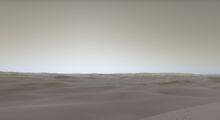
Image taken by one of the passengers of Venus' surface a day before the lightning storm incident.
Visit to Venus[]
Upon departure and with a gravitational boost from Earth, the Tour’s first stop Venus. The ships entered orbit on February 10, 2121. They remained in orbit for two weeks and during that time the ships delivered supplies to the still new Venusian colonies and even allowed for some of those who had paid for a seat to travel to the small floating laboratories in order to get a better look at the clouds as well as take a brief journey to the surface.
During this trip down disaster almost struck. During one of the tours of the Venusian surface, a large lightning storm overtook the rovers and struck two of them, causing explosive decompression in the cabins. However, both drivers had been keeping a close eye on the weather patterns and had, only fifteen minutes before, instructed the passengers to place their Venusian spacesuits on.
With the destruction of two of the rovers, the passengers had to squeeze into the three remaining ones while still in their spacesuits so as not to deplete the air supply for the other passengers. Aside from a few bruises and scrapes, miraculously no major injuries were reported. However, surface tours were banned for the remainder of their stay. The tour left on March 4, 2121
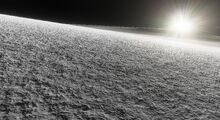
Image taken of Mercury's surface by one of the passengers.
Visit to Mercury[]
The journey to Mercury took nearly twice as long for the tour to reach. After using Venus as a gravitational boost, the tour slowly glided into Mercury’s orbital plane, making their way into orbit on May 24, 2121. The tour remained there until June 5, during which time the scientists and researchers on board sent down various instruments with which they could study the Sun as well as Mercury itself. Five days after arrival, each ship sent down landing parties to the Mercurian north pole.
A temporary camp, named Hermes 1, was set up in one of the craters and those who went down stayed for a total of three days before returning to their respective ships. On June 5, the ships used a gravitational boost from Mercury as well as some extra speed from the nuclear engines in order to move to the outer worlds.
Return to Earth[]
In order to reach a speed fast enough to reach Mars, the tour had to return to Earth via gravity boost from Venus. The ships reached Venus on July 1 of that year but had to make an emergency stop for five days when the Aphrodite Beta station began experiencing major malfunctions that required immediate evacuation. Since the Alpha and Gamma floating stations had no means with which they could sustain the extra mass and bodies, the Tour Fleet, which was on its way back to Earth, took on the extra hundred people.
On July 6, after finding temporary quarters for each of the Beta research teams on the five ships as well as working out a rationing system on each vessel, each spacecraft activated its nuclear engines and sped up their orbits around Venus. In order to reach Earth in a timely manner they had to use more power than they were expected to.
Not only were they needing a resupply, but about twenty of the passengers were showing the beginning signs of cancer despite each ship’s magnetic shielding against the solar radiation.
On August 11, the Tour entered into Earth orbit upon which all but the skeleton crew disembarked temporarily. Some, however, wished to remain on Earth permanently as they had grown tired and bored of the long months of space travel between planets. Due to the orbits between Mars and Earth not being optimal for a slingshot maneuver at that point in time, the tour was put on hold as scheduled until January of 2123.
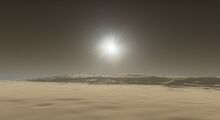
Image of Mars taken by one of the passengers.
Visit to Mars[]
On December 27, 2122, the remaining passengers along with new ones went up to the five ships, which had been repaired and reinforced with new magnetic shielding and stronger shells around the outer and inner hulls. Fresh supplies were sent up on December 31. On January 6, the engines started up and with a gravity boost from Earth, the tour began their journey to the outer planets.
On March 29, the tour ships entered into orbit around Mars and remained in orbit for around a month, during which time each of the passengers were given the chance to descend to Arestown and explore the large domed city.
Near the end of the month, sixty-five of the tour passengers, led by a Sir Walter Desmond, informed the leaders of the expedition that they wished to live in Arestown. Twelve of these passengers included some of the scientists on board. Most of the next month was spent in negotiations between these hopeful new Martian colonists and the leaders of the tour, as the former wished for the tour to relinquish some of the foodstuffs meant for the colonists. Eventually a compromise was reached in which these tour passengers were granted a spot on the newly constructed Phobos habitat which was manned currently by a skeleton crew. On April 26, the ships left Mars orbit and headed to Jupiter.
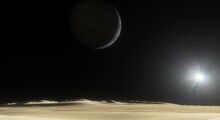
Jupiter from Io. This picture was taken mere hours before the cave collapse on Io.
Visit to Jupiter[]
The time it took for the journey between Mars and Jupiter was by far the longest in the tour, lasting until October 31, 2123. Upon entering orbit, each ship celebrated with a massive arrival/Halloween party. The Tour remained at Jupiter for three months, taking the time to land on and explore the Galilean moons.
On November 12, the ships entered orbit of Io and each sent down landing parties. Two days later, disaster struck the tour once again when a team exploring an extinct lava tube was buried during a large cave-in. Every team member was saved, but one of them had to have their leg amputated due to the irreversible damage caused by the cave-in. They were given a prosthetic leg but they were not allowed to land on any other of the planetary bodies visited throughout the tour for safety reasons.
On December 3, the colonists landed on Europa near the site of first contact between the Kya and humanity. Some of the passengers were even allowed to put on amphibious spacesuits and swam with the friendly Kya. Ten days later, they left but not without one of the most famous human-alien exchanges taking place, known today as the Kya Discussions, written by one of the tour passengers.
On December 23, each ship connected to one another, creating a massive ship. The purpose of this was to boost morale among the passengers with a large Christmas party which lasted from 0800 hours on December 24 to 2300 hours on December 25.
On January 19, 2124, a simultaneous landing took place. The Niña, Pinta, and Santa Maria each took up orbit around Ganymede while the Columbus and Leif Erikson took up orbit around Callisto and each ship landed on each planetary body. Five days later, the passengers returned to their ships and began to prepare for departure.
On January 29, the passengers left Jupiter’s orbit.
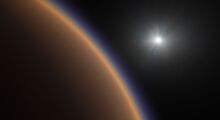
Titan as seen from orbit by the Santa Maria.
Visit to Saturn[]
On June 16, 2124, the fleet arrived in Saturn's orbit. They remained in the Saturnian system for two months.
During this time the fleet split up. The Niña, Pinta, and Santa Maria took up orbit around Saturn’s moon Titan and established a base on the planet not just for themselves but for others who would likely follow.
The Columbus and Leif Erikson remained in Saturn’s orbit, studying and capturing pieces of Saturn’s rings for further study. Many pieces of the rings were brought in and used to add to the water supply of the ships. They discovered evidence that life had once existed on Titan during its earlier warmer days but had since gone extinct.

A rare cloud break on Titan showed the tourists what Saturn looked like from the surface.
Each ship sent out probes which landed on the other major bodies orbiting Saturn. One of the probes which landed on Enceladus sent back unusual readings: vibrations from within the icy moon. The Leif Erikson sent out a group of researchers to study Enceladus and attempt to determine the source of the unusual vibrations. However, the researchers had a very little window with which to study the moon It wasn’t until 2132 during the Project Deepdive mission when the Enceladus Subsurface Ocean Explorer discovered the source of the unusual vibrations to be the Cheli, small eel-like creatures living in the subglacial ocean.
Another manned mission was sent to Mimas where those sent set down near Herschel Crater in order to study the moon and how it managed to keep its spherical shape.
The fleet left on August 2, 2124.
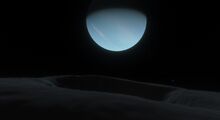
Uranus as seen from one of the craters on Miranda. Taken by one of the passengers.
Visit to Uranus[]
The trip to Uranus took over two years, but the fleet eventually reached Uranus on December 21, 2126. The fleet then split up once again, each setting up orbit around Uranus’ major moons and setting up a temporary camp on each moon for the passengers to be able to explore the moons from them.
During their stay, the astrophysicists studied Uranus in an attempt to learn more about its unusual orientation. During the three month stay, they discovered evidence that Uranus was struck early in its history by a smaller body, the remnants of which formed the ring system.
During the exploration of each of the moons, no evidence of any life was discovered on any of the moons.
The fleet regrouped and left the Uranusian system on March 23, 2127.
Visit to Neptune[]
The travel time to Neptune would have taken much longer had the passengers not petitioned for the nuclear engines to be burned for a month longer. This caused the journey to Neptune to be shortened by two years. The vessels arrived in Neptunian orbit on November 11, 2130.
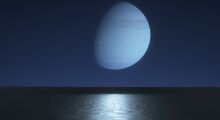
View of Neptune from Triton. Proteus can be seen passing between Triton and Neptune. This picture was taken a week before the Neptune Mutiny. Visitors described the moon as being "...in perpetual twilight."
The fleet set up in orbit around Triton and set up a base camp on the surface, meaning to allow everyone to land on the surface and each person on the tour vessels spending a week on the surface. The tour stayed in the Neptunian system for three months, studying and visiting the planet and its major and minor moons, taking samples and in some cases souvenirs. The biologists discovered no evidence of life, past or present, on Triton.
Two months in, there was a major mutiny on the Leif Erikson. The majority of the passengers on board were demanding that the ship be turned around and head home as quickly as possible. Now known as the Neptune Mutiny, this miniature war on the ship caused the deaths of fifty-seven passengers. Unfortunately, this mutiny orphaned at least ten children. Order was reestablished about two weeks after the mutiny began and the children were adopted by couples on the other tour ships. A week was set aside for the mourning of the dead as well as a mass funeral service.
When the three months were up, the fleet aimed towards the inner Sol System and activated the nuclear drive for the final time, leaving the Neptunian system on March 19, 2131.
Return to Earth[]
The return journey to Earth took a total of over eleven years. On May 2, 2142, the Tour officially ended, bringing back the remaining passengers along with the forty-one children born on the Tour.
Legacy[]
The tour vessels were placed together for the last time on June 1, 2142 and then each section was fused shut. The Sol System Tour Station became one of Earth’s most famous Lagrange Point habitats as well as a museum.
The SST Station has been maintained in Earth orbit ever since its return and fusing. Some of the inhabitants on the station claim that their roots can be traced back to the Tour Families that formed during the legendary exploration of the system.
